There’s little more exciting than having a bouncing, excitable new puppy to look after. The turbulent teething stages, however, may have you feeling like you’ve bitten off more than you can chew. So how do you help with puppy teething, what are puppy teething symptoms, and how do you stop a teething puppy from chewing everything in sight?
We know this can be a trying period of time for new puppy owners, so in this article we’ve laid out all the tips and tricks for puppy teething relief.
Remember: no matter how stressful it is, you’ll one day reminisce about when your pooch was this small and hectic (no, seriously!).
When do puppies start teething?
Puppies’ baby teeth come in super early - from as young as 2 weeks old. From the age of around 3 months, those 28 baby teeth will start to fall out for a full set of 42 adult teeth to come through. This can be painful and stressful for a puppy, just like it is for young humans to grow and lose teeth.
How long does puppy teething last?
Puppy teething ends when they’ve lost their puppy teeth and they’re replaced with all their adult teeth. This is usually around 7 months of age, making the teething period around 3-4 months long.
In some breeds (such as Chihuahuas and Jack Russells), it’s common for puppy teeth to be a bit stubborn and not fall out on their own. This can sometimes be harmless, but can often lead to other complications and infections. If you’re concerned about your puppy’s teeth not falling out as they should, be sure to make an appointment with your vet.
When’s puppy teething at its worst?
The most uncomfortable teething period for your pup will be from the 3-4 month mark; however it might vary slightly depending on their breed. At this time, your pup’s gums will be sore and aching as baby teeth fall out and adult teeth cut in. They might be especially irritable and a bit of a handful to deal with.
Key puppy teething symptoms
Let’s go into the key signs that your puppy is well and truly teething

-
Wound up and irritable. Puppies are adorable, but they can be a nightmare at times (!) - and part of that is down to teething. An increase in irritable behaviour is a tell-tale that teething’s started, so use this knowledge to practise some patience for your distressed pup.
-
Chewing anything and everything. One of the most challenging parts of a teething puppy’s behaviour? Chewing anything in sight! That includes table legs, the sofa, your bag or shoes, and your hands, feet and ankles.
-
Drooling. A puppy with sore gums will drool a lot more than when they’re not teething.
-
Pawing at face. A sure indication that your pooch has a sore mouth is if they’re visibly pawing at their face and snout.
-
Wayward baby teeth. When a puppy’s teething, you’ll find baby teeth everywhere - stuck in chew toys, in their food bowl or even just lying about the house. This may be a shock at first, but it’s perfectly normal and actually a good sign. Conversely, if you never see any teeth, this is quite normal too, as they can be swallowed.
-
Crying/whimpering. Your puppy might make a lot more noise for your attention when they’re teething, specifically at night when there isn’t as much to distract them from their sore mouth.
-
Spots of blood. You may see tiny blood spots on anything your pup’s chewed, such as bits of towel or fabric, or even your cushions and furnishings.
-
Off their food. A teething puppy might find it too painful to eat, and won’t be as hungry for food as you’d expect.
How to help a teething puppy
When your poor pup’s struggling with teething, it’s your job to do everything possible to make the process as pain-free as possible, and be patient with their often mad behaviour.
Although in general, you’ll simply need to ride this out for a few months, there are ways to make your pup’s life (and yours!) more comfortable.
Lots of chew toys
Just like with babies, the go-to method is to give your pup something to chew on to subside the pain. Be sure there are lots of toy variants on offer, ones that are specifically for teething and others that offer different textures - and rotate them.
For added soothing effects, pop them in the fridge or freezer before you offer them to pup. Having chewable toys on hand will distract your pup from biting your belongings, furniture, your arms and sometimes ankles.
Lots of dog toys are made to be addictively chewy - others are specifically made to alleviate teething, so stock up.
Healthy dog treats
Some dog treats are good for teething pups, and may include ingredients to calm them and soothe pain, such as hemp or turkey. Be sure to check they’re suitable for puppies before feeding new treats or foods.
Set boundaries for chewing
By now you’ve probably noticed - the teething stage is like a non-stop chewing festival for puppies, and can be very destructive. Use this time to set boundaries with your pup, by puppy-proofing your home and teaching your pooch early training around chewing and biting (read on for more info on this).
Teach ‘bite inhibition’
Teething puppies will naturally bite whatever they can get their little snouts on, including your skin. Why not take advantage of this early stage of their development to teach ‘bite inhibition’?
This means when they bite too hard, firmly say ‘no’. If they continue, remove yourself from their presence. When they learn to stop biting on demand, reward them with a treat. Eventually, they should learn to never bite so hard that it causes harm to other dogs or humans, even when significantly stressed (when in the vet, for instance).
Frozen food
Some frozen foods offer light pain relief and are distracting for puppies to chew. A carrot popped in the freezer, for instance; or chopped bits of strawberry, banana or cucumber slices would keep a bitey pup entertained and relieved for a while.
Feed wet puppy food
If you’ve been feeding your puppy dry food, it might be worth your time to switch to
wet puppy food while they’re teething. This will be much easier for them to munch on and is especially advised if you think your pup’s eating less due to their aching gums.
Can I give my puppy a carrot for teething?
Yes - carrots are great, harmless ‘chew’ foods for a teething puppy. They offer just the right consistency so your pup can munch to soothe their aching gums, potentially dislodge baby teeth, and they’re healthy too. Popping a carrot in the freezer for a while will keep it satisfyingly cold.
What’s the washcloth remedy?
One age-old trick you can try at home is to take a clean washcloth, soak it in water or puppy broth and tie it into knots - then pop it in the freezer until solid. Lay it in front of your puppy to give them plenty of teething distraction, by gnawing on this homemade chew toy ‘til their heart’s content.
What can I give my teething puppy for pain?
Your poor pup will feel significant discomfort while teething. To reduce this pain as much as possible, try putting chew toys on rotation in the fridge or freezer, or try the ‘washcloth trick’. If your puppy’s still in pain, your vet may recommend some pain relief, but this would be uncommon. Be sure to talk to your vet about the correct dosage, if you do use a puppy teething gel or any oral medicine.

How to stop a teething puppy from chewing everything
You’ll find that a puppy is never more destructive than when they’re teething. The key to avoid your skin, possessions and furniture being endlessly gnawed on is to have lots of distracting items for pup to bite instead. Stock up on chew toys, healthy treats and cold, munchable food - and your pained pooch should soon understand what they’re free to chew on, and what they not!
How to puppy-proof your house at teething age
Of course, it’s much clearer to your dog what’s okay to bite on when chewy things are readily available, and out-of-bounds items are hidden:
- Puppy-proof your house by keeping your valuables out of sight and out of reach. Do the same for hazardous items - including anything they could choke on or get ill from.
- Elevate to higher levels anything you don’t want your puppy to chew.
- Create ‘puppy safe’ areas full of toys, treats and distractions, perhaps using a puppy or baby gate to keep them secure.
- Over time, teach commands such as ‘leave’ and ‘drop’ so your puppy knows to keep their gnashers away from table legs, wires and furniture.
How to help puppy teeth fall out
The goal of teething is essentially for baby teeth to fall out and make room for adult teeth. This should happen without intervention. If your puppy’s losing teeth but the process seems too slow, you can help it along by providing chew toys, soft puppy food or
dental treats, and by inspecting their teeth and gums with a finger.
Don’t try to pull any teeth out manually. If you’re concerned about your puppy losing teeth too slowly, ask your vet to check them over, as sometimes the vet will need to remove them surgically.
How to help a teething puppy sleep
Much like a baby, puppies might cry and whine overnight while teething - your poor pup will be like this for a while. You can help a teething puppy sleep by following a regular sleep schedule, maintaining a cool, calming environment for your pup, and providing them with cold chew toys just like they’d have during the day.
Avoid any unnecessary overstimulation before bed. This period will seem a lot to deal with - but soon your pooch will be fully grown and you’ll miss this puppy stage! We promise!
What to do if a teething puppy isn’t eating
If your
pup isn’t eating because they’re teething, try mixing up their usual food to lure them back to the bowl. A puppy who eats dry food will benefit from the softness of wet food - or you could dry adding warm water or gravy to the dry food to soften it up.
Make use of healthy puppy treats and frozen, chewable food, too. Get in touch with a vet if your pup still won’t eat anything.
The puppy teething period may have you pulling your hair out at times, but find solace in the fact that it only lasts a few months - and it’s an important time for your puppy to learn key skills to take into their adult dog life.
For healthy food and chews to distract your puppy from teething, try our range of puppy food and supplements. Our grain-free Puppy Wet Food is packed with nutritious, whole ingredients to help your pup develop, while also being perfect for sore gums and growing teeth.






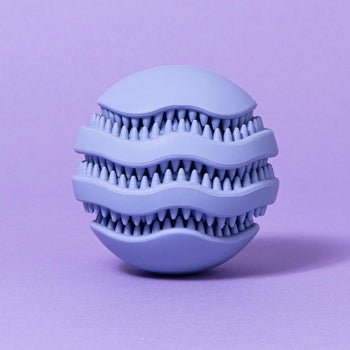



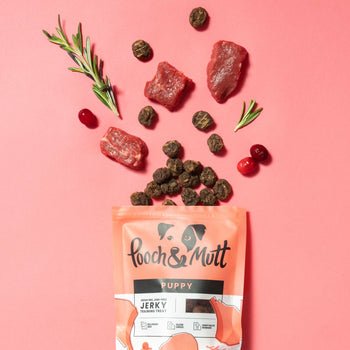
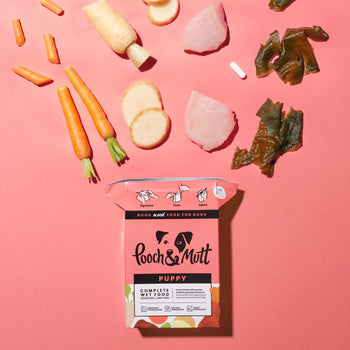

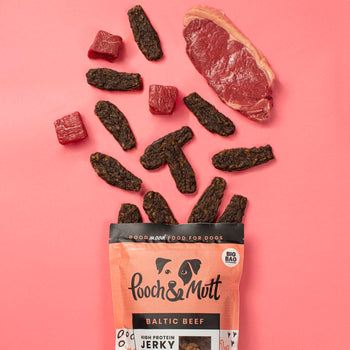






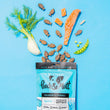

Comments (13)
We have a three month old sprocker who is delightful most of the time but will suddenly go into biting mood and bite arms hands, in fact any part of us. This is painful, we have started shutting her into another room for a short while to calm down. This seems to work most of the time, are we doing wrong?
Hi Margaret, it certainly sounds like your pooch is in the teething stage and you are removing yourself from their presence when it gets too much. To teach ‘bite inhibition’ ensure you are firmly saying ‘no’ several times before moving them away and then when they learn to stop biting on demand, reward them with a treat. You can reach out to the team any time at [email protected] for further advice
almost 3mos.old TeddyBear Breed, 2& 1/2 lbs. He is a Kujo & draws blood when he bites, if you discipline him, he is more aggresive & barks at you. Husband does not like this at all. Breed behaviour or will this too pass?
Hi Louise,
Many puppies do go through a ‘biting’ phase and this can sometimes be due to teething or that they are trying to play. However, it you are at all concerned about aggression, we would always recommend seeking professional advice from an accredited behaviourist or trainer for further guidance as there can be many underlying causes!
We have a 20 week old Rhodesian Ridgeback pup (25kg) who has just started loosing his puppy teeth. He is now acting like he is over tired all of the time due to being uncomfortable. He has all of the chew toys and frozen cloth items but he still chews anything he can get to. When he is at his worst we just calm him down by comforting him and talking soothingly to him. It takes a while but it eventually works. He will often gently chew your hand while calming down !lol.
Hi! i have a 4 months old mini dachshund puppy, she is lovely but bites anything and everything she finds, socks, hands, shoes, etc. her toys are completely destroyed, kongs are too big for her and she isnt particularly interested in rubber toys, she mostly likes plushies which she destroys and tries to eat the filling, she isnt really interested in her kibble right now, she mostly wants meat or vegetables. What should i feed her? if i only give her soft food will she not eat her kibble? what kind of toys would you recommend? how do I stop her from biting hands or faces(specially noses)?
Hi Daniela,
It sounds as though she may be teething and exploring with her mouth! Distracting with toys can be a good way to redirect this behaviour and something like our Snuffle Ball, where you can hide treats may be a good choice to promote engagement and mental stimulation. Of course, we would always recommend seeking advise from a professional behaviourist/trainer if you do need further support.
You may want to consider feeding just one, or combining both our Puppy Complete Superfood (dry) and Puppy Wet Food and finding a balance your pup enjoys. These foods are designed specifically to support growing pups and ensure you are giving your puppy everything they nutritionally need, and that they feel good on the inside and the outside. If you would like any further advice/ feeding guidelines please reach out to the team at [email protected] :)
I have a 9 week old labrador retriever puppy. Is ot too early for him to be teething as he is eating everything including me! I’ve tried chew toys and “trading” my arm or shoe for a treat but he’s drawing blood. Carrots from the fridge seem to be quite good and hes not vicious just a destruction machine. Help
Hi Sally,
Pups do very often explore with their mouths and they are also very excitable wanting to play, where they can often get a little carried away! Keeping your pup occupied with enrichment activities can also be helpful, for example filling our Snuffle Ball toy with yummy Beef Jerky Puppy Treats! Remaining consistent with training is also very important and we would advise seeking further advice from a professional behaviourist or trainer if things don’t seem to be progressing :)
My puppy is 10 weeks old and bites everything, paws at her face, cries often but she won’t stop biting isn’t this a little early to be teething,
Hi Chelsea,
This could be the start of teething, however it is also worth noting puppy’s do explore with their mouth! Toys can be a great way to redirect this behaviour, for example our Patch toy, or even our Snuffle Ball, where you can hide treats to promote engagement and mental stimulation. Of course, we would always recommend seeking advice from a professional trainer or behaviourist if you are at all concerned and do need further support.
I have a 17week boxer pup who cries because of his teeth, he doesn’t seem to of lost any yet, he has a hymalian milk chew that he chews like crazy, can you suggest anything else?
Would he be ok now with a frozen carrot? I’m worried about choking, we’ve had a nightmare finding the right food for him as he has a very sensitive tummy, so at the moment his on wet food. His not a lover of any kibble…… I don’t want to upset his tummy but his crying is so sad 😞
Hi Emma,
Oh I am sorry to hear this, and do hope he is doing ok! We wouldn’t usually recommend very tough chews until 6months+ as teeth are not yet full developed and we wouldn’t want to cause any harm.
Carrots aren’t too hard and are a great healthy treat (especially when frozen) to help soothe your pups gums. You can also try other fruits such as frozen strawberries or bananas and the washcloth trick mentioned in this article where you soak and freeze a washcloth for your pup to chew at.
Leave a comment